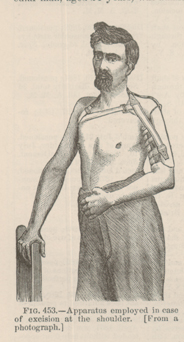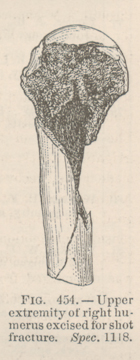Title: Woods, E. H.
Source text: The Medical and Surgical History of the War of the Rebellion. (1861-65.), Part 2, Volume 2 (Washington, DC: Government Printing Office, 1876), 580.
Civil War Washington ID: med.d2e30256
TEI/XML: med.d2e30256.xml
CASE 1560.—Private E. H. Woods, Co. G, 6th Maine, was wounded at Chancellorsville, May 3, 1863, and was admitted to Mount Pleasant Hospital, Washington. Acting Assistant Surgeon E. Coues reported: "The patient, a very robust muscular man, aged 24 years, was admitted May 8th. A minié ball had entered the outer anterior aspect of the shoulder, passed backward and inward, and badly comminuted the upper portion of the humerus, the fracture extending up into the joint. Operation of resection of five and a half inches of the humerus with the head was performed, May 15th, by Assistant Surgeon C. A. McCall, U. S. A." The specimen (FIG. 454) consists of the head and three and a half inches of the right humerus. The anterior face of the shaft and posterior portion of the head are carried away, and the articular surface is split in two vertically. It was contributed by the operator. The patient recovered and was discharged the service, and pensioned November 13, 1863. At that date, Examiner T. B Smith, of Washington, reported: "Ball entered the shoulder an inch below the coracoid process, and passed backward, fracturing the humerus in the upper portion. Resection of the head and about three inches of the shaft in consequence. Hand motions perfect, but unavailable for labor by reason of uselessness of the arm; may improve much in a couple of years." In November, 1865, Dr. E. D. Hudson, of New York, furnished this man with an artificial limb, and reported that there had been an excision of five inches of the shaft and head of the humerus through a linear incision, posteriorly, of the deltoid, and that the arm was shortened three-fourths of an inch, with slight atrophy. The general condition of the arm was excellent, the interspace being mainly filled with new growth of the continuity. The usefulness of the apparatus while under observation was very satisfactory. Dr. Hudson contributed a photograph, represented in the accompanying cut (FIG. 453), showing the mode of adaptation of the apparatus to the limb, and another giving a view of the patient, showing the cicatrix, which will be found on page 2, Vol. IX, Contributed Photographs, A. M. M. In June, 1867, Examiner A. H. Agard, of Sandusky, Ohio, reported: "The excised end or stump has not formed a joint, but plays all about, rendering the arm quite useless for purposes of manual labor." The pensioner was paid March 4, 1874.

